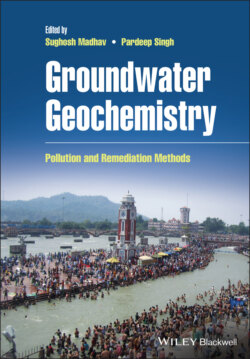Читать книгу Groundwater Geochemistry - Группа авторов - Страница 60
2.5.3.5 Reverse Osmosis
ОглавлениеA tank divided into two parts with the help of a semipermeable membrane comprises a reverse osmosis system. Fluoride‐contaminated water passes via semipermeable membrane with the help of hydraulic pressure on a side of tank. Along with water, few impurities also cross the semipermeable membrane, whereas salts and other impurities cannot cross the membrane (Dubey et al. 2018). Successful filtration of various impurities with different sizes has been reported while crossing the semipermeable membranes by exerting pressure. In the process of reverse osmosis oman‐induced pressure toward the contaminated water side of the membrane proved to be advantageous to overcome the naturally occurring osmotic pressure that flows in the opposite direction. In order to enhance the reaction speed of the process some more osmotic pressure has been added by forcing water across the semipermeable membrane toward the opposite, clean side (Demeuse 2009; Water Professionals 2018). According to reports, reverse osmosis results in accessing a better quality of drinking water, having salinity less than 0.1 g salts/L (Mazighi et al. 2015). Ions residing in water could be carried via membranes with the help of electric currents in the electrodialysis process. The two major parameters affecting the performance of membrane are pH and temperature. The ability to remove fluoride via the reverse osmosis process varies from 45 to 90% by increasing the pH level from 5.5 to 7. Some problems associated with reverse osmosis are chemical attacks, fouling due to particulate matter, plugging of membrane, and producing large quantities of waste. The waste generated by this process is much more than in the ion exchange process. Pretreatment of raw water must be carried out before introduction into the production unit if the raw water condition is not optimal. Another demerit is eliminating all the ions of contaminated water. As we all know, humans require minerals for proper growth and metabolism thus remineralization of reverse osmosis‐treated water is required, hence increasing the cost of the process in comparison to other options. This method involves more financial input as the purification process makes water more acidic, thus several pH corrections are required, generating lots of brine waste (Kumar and Gopal 2000). The important points of consideration for the reverse osmosis membrane selection method are recovery of purified water, raw water composition, pretreatment steps, cost, rejection properties, etc. (Jagtap et al. 2012; Yadav et al. 2017; Yadav et al. 2018).
